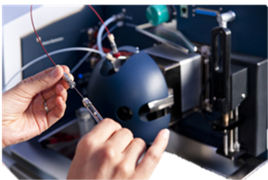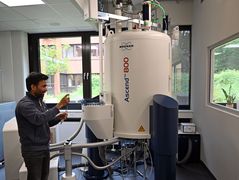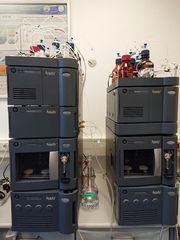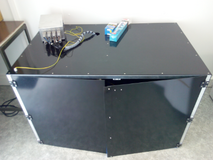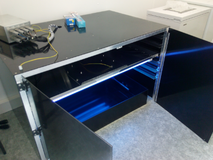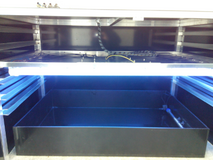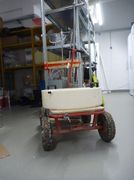Dissolved organic matter contains a suite of organic molecules that can be separated and quantified using liquid chromatography. Prominent examples are individual amino acids and carbohydrates. There are also components in DOM that can be traced through characteristic products after specific chemical treatment, e.g. dissolved lignin (lignin phenols) and dissolved black carbon (benzenepolycarboxylic acids).
Ultra performance liquid chromatography (UPLC) uses the principles of high performance liquid chromatography (HPLC) but works with pressures of up to 1000 bar. Applying such high pressure, particle sizes in the separation columns can be much smaller (< 2 µm), which increases separation while reducing run time, sample volume and solvent use.
UPLC system I:
Waters Acquity UPLC®: Binary Solvent Manager, Sample Manager, Column Manager, PDA eλ Detector
UPLC system I is equipped with a photodiode array absorbance detector. This system is used for routine analysis of benzenepolycarboxylic acids (BPCA). The column manager can hold up to four different separation columns, providing a helpful tool for method development.
UPLC system II:
Waters Acquity UPLC®: Binary Solvent Manager, Sample Manager, FLR Detector
UPLC system II is equipped with a fluorescence detector. Main application of this system is amino acid analysis.
Contact:
Jutta Niggemann
W3-1-218
0441 - 798 3365
jutta.niggemann@uni-oldenburg.de
Key publications:
Benzenepolycarboxylic acids (dissolved black carbon):
Dittmar, T. (2008) The molecular level determination of black carbon in marine dissolved organic matter. Organic Geochemistry 39: 396-407
Jaffé, R., Ding, Y., Niggemann, J., Vähätalo, A.V., Campbell, J., Dittmar, T. (2013) Global charcoal mobilization from soils via dissolution and riverine transport to the oceans. Science 340(6130): 345-347
Lignin phenols (lignin):
Chmiel, H.E., Niggemann, J., Kokic, J., Ferland, M.-E., Dittmar, T., Sobek, S. (2015) Uncoupled organic matter burial and quality in boreal lake sediments over the Holocene. Journal of Geophysical Research: Biogeosciences 120: 1751-1763
De la Cruz, F.B., Dittmar, T., Niggemann, J., Osburn, C.L., Barlaz, M.A. (2015) Evaluation of copper oxide oxidation for quantification of lignin in municipal solid waste. Environmental Engineering Science 32: 486-496

![[Translate to English:]](/f/5/_processed_/3/2/csm_ICBM-Logo-transparent-_91fe1c6774.png)

